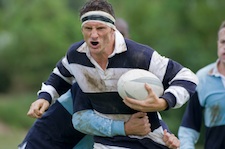Rugby Training
Rugby is one of the most physically demanding games in terms of player injuries. Since both Rugby Union and Rugby League have gone professional injuries have increased nearly 50% due to rugby players becoming physically stronger and faster and playing with generally more determination.
 With serious injuries at the rate of 1 an hour during play, it is understandable that rugby players at all levels are now wearing padded clothing and headgear.
With serious injuries at the rate of 1 an hour during play, it is understandable that rugby players at all levels are now wearing padded clothing and headgear.
A strength / fitness training program will certainly assist all levels of rugby players, regardless of the position or style of game played, or even the sexes as rugby is certainly becoming more and more popular as a female sport.
Played under two different rules, Rugby League, and Rugby Union. Used to be called "A mans Game", however it is becoming increasingly popular with females. A game of two 40 minute halves with teams of 15 players (Union) 13 players (League), who are generally well built especially for Rugby League. To become good at this sport, you will require a range of physical abilities, as well as a strong mental attitude with good discipline.
There are a wide variety of shapes and sizes on the Rugby pitch, with each individual having their set role in the game. With players amalgamating as a team, every player can benefit from the following basic physical requirements, to develop a team with no weak links.
Explosive acceleration and fast sprinting speed.
Look at the plyometric circuit to developing explosive power, aim to do this circuit no more than once a week, and certainly not on days before a game, as this type of circuit takes a few days to recover from.
Shuttle sprints; most sprints / runs last for between 10 and 50 seconds in a game, so look at this time for your training. Working with minimal rest between sessions, ideally 15 seconds, however every 5 minutes, take a good minute break whilst walking / jogging. Your sprints should take the following form, standing start, lying flat on your stomach start, running start, sprint forward with run back and then repeat all with a ball.
Working at speed whilst passing the ball will help develop the high level of skill that is required for hand eye co-ordination.
Aim to have a minimum of 5 markers to turn around, not necessary in a straight line when you perform your shuttle sprints. Also concentrate on turning around the marker from both sides, most right footed players will go around from the right, if you are strong on turning at speed on both legs, just think how this will improve your game?
Dependent upon the position you play, will determine the amount of speed work that you perform. The Backs, players (1-9) should perform at least two sessions of speed drills for about 20 –30 minutes a week, with 1 plyometric session. All others should aim for 1 plyometric session and 1–2 speed sessions of 15- 25 minutes.
The following pages will provide some useful training workouts and foot drills to improve your Rugby Fitness.